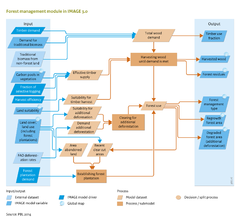Forest management/Policy issues: Difference between revisions
Jump to navigation
Jump to search
No edit summary |
No edit summary |
||
| Line 1: | Line 1: | ||
{{ComponentPolicyIssueTemplate | {{ComponentPolicyIssueTemplate | ||
|Reference=PBL, 2010; Brown, 2000; | |Reference=PBL, 2010; Brown, 2000; | ||
|Description=In most baseline scenarios, areas of forest management increase. The IMAGE forest management model was used in the scenario study ‘Rethinking global biodiversity strategies’ on future biodiversity developments ([[PBL, 2010]]). The study projects that, in the absence of additional forestry policy, the area of forest plantations will increase only slightly between 2000 and 2050 (from 1.1 to 1.2 million km2). The total forest area for wood production will increase from 9.5 to 14.5 million km2 (Figure below, left panel). According to this projection, by 2050, just over a third of the global forest area will be used for wood production and consequently. In the same year, the area of primary forest, defined in IMAGE as established before 1970 and not exploited since, will decrease by more than 6 million km2 from almost 30 million km2 in 2000. | |Description=In most baseline scenarios, areas of forest management increase. The IMAGE forest management model was used in the scenario study ‘Rethinking global biodiversity strategies’ on future biodiversity developments ([[PBL, 2010]]). The study projects that, in the absence of additional forestry policy, the area of forest plantations will increase only slightly between 2000 and 2050 (from 1.1 to 1.2 million km2). The total forest area for wood production will increase from 9.5 to 14.5 million km2 (Figure below, left panel). According to this projection, by 2050, just over a third of the global forest area will be used for wood production and consequently. In the same year, the area of primary forest, defined in IMAGE as established before 1970 and not exploited since, will decrease by more than 6 million km2 from almost 30 million km2 in 2000. | ||
|Example=Several policy interventions on forest management can be simulated in the IMAGE model 3.0: | |Example=Several policy interventions on forest management can be simulated in the IMAGE model 3.0: | ||
| Line 8: | Line 8: | ||
* more reduced impact logging (RIL) techniques, less conventional selective felling. | * more reduced impact logging (RIL) techniques, less conventional selective felling. | ||
The scenario study [[Rethinking Biodiversity Strategies (2010) project|‘Rethinking global biodiversity strategies’]] implemented the following two ambition levels for improved forest management as alternatives for the baseline trend (Figures | The scenario study [[Rethinking Biodiversity Strategies (2010) project|‘Rethinking global biodiversity strategies’]] implemented the following two ambition levels for improved forest management as alternatives for the baseline trend (Figures above and below): | ||
# Moderate ambition level: partial substitution of conventional selective felling in tropical forests with RIL techniques, and forest plantations targeted at supplying 25% of the global wood demand; | # Moderate ambition level: partial substitution of conventional selective felling in tropical forests with RIL techniques, and forest plantations targeted at supplying 25% of the global wood demand; | ||
# High ambition level: full substitution of conventional selective felling with RIL techniques as of 2010, and forest plantations targeted at supplying 40% of the global wood demand by 2050. This represents a plausible future development of plantation growth ([[Brown, 2000]]). | # High ambition level: full substitution of conventional selective felling with RIL techniques as of 2010, and forest plantations targeted at supplying 40% of the global wood demand by 2050. This represents a plausible future development of plantation growth ([[Brown, 2000]]). | ||
The ambitious improvements in forest management will result in considerably less land used for forestry by 2050 (about 10 million km2, or one third smaller area than under the baseline scenario) (see Figure above). With the reduced forest area, and the assumed positive effects of {{abbrTemplate|RIL}} techniques, biodiversity loss caused by forestry will be reduced. For the lower ambition level, gains will be smaller with forestry area expanding well over 3 million km2, and less biodiversity loss prevented. | |||
The ambitious improvements in forest management will result in considerably less land used for forestry by 2050 (about 10 million km2, or one third smaller area than under the baseline scenario). With the reduced forest area, and the assumed positive effects of {{abbrTemplate|RIL}} techniques, biodiversity loss caused by forestry will be reduced. For the lower ambition level, gains will be smaller with forestry area expanding well over 3 million km2, and less biodiversity loss prevented. | |||
|IMAGEComponent=Biodiversity | |IMAGEComponent=Biodiversity | ||
}} | }} | ||
Revision as of 15:21, 21 May 2014
Parts of Forest management/Policy issues
| Component is implemented in: |
| Components: |
| Related IMAGE components |
| Projects/Applications |
| Key publications |
| References |
